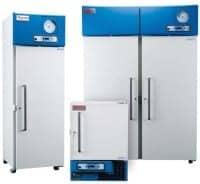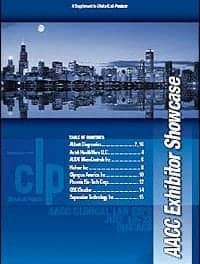Heparin-induced thrombocytopenia Type II (HIT) is an acute, immune-mediated process that may result in life-threatening thrombosis.1 HIT is caused by heparin-dependent antibodies formed to complexes of heparin/platelet factor-4 (HPF-4).2,3 These antibodies are initially formed when a patient has been on heparin therapy for 5 or more days. An immune response to a heparin dose may be observed within minutes or hours if the patient has had previous exposure to heparin and HPF-4 antibodies are already circulating.4 The hallmark symptoms of HIT are a drastic fall in platelet count, with or without thrombosis; other symptoms may include cutaneous reactions, from a simple allergic reaction to lesions to necrosis.5

The awareness of HIT has greatly expanded in the past few years as the incidence and resulting sequelae have become increasingly understood. HIT is observed in 1% to 5% of patients treated with unfractionated heparin (UFH) during surgery, treatment for deep-vein thrombosis, or following incidental exposure through heparin flushes or subcutaneous administration, or by heparin-coated catheters or prostheses.6,7 The risk of thrombosis in patients who develop HIT is at least 33% to 50%.6,8 Subsequent risks of HIT with thrombosis are mortality (30%) and limb amputation (20%).9,10 In addition, HIT-associated thromboembolic events may increase hospital stays with a cost of at least $8,000.11
In patients recently exposed to heparin, the diagnosis of HIT is based on a combination of clinical features (signs, symptoms, and clinical settings) and appropriate laboratory findings. Neither clinical features nor laboratory findings alone are sufficient to accurately diagnose HIT. Rather, a synthesis of all available information is required.12 Since the ultimate goal is to recognize patients who are at risk of HIT prior to the development of a potentially devastating thrombotic event, laboratory results are critical—particularly the platelet count and HPF-4 antibody status. The importance of clinical setting is underscored by the fact that HPF-4 antibodies are observed in as many as 50% of patients following cardiopulmonary bypass surgery, 15% of patients following major orthopedic surgery, and 12% of patients presenting with symptoms of chest pain or thrombosis in the emergency department.6, 13
Currently, four testing methods are used to help identify patients with HIT: C-14 serotonin release assay (“SRA”), Platelet Aggregation Test (PAT), Enzyme-Linked Immunoassay (ELISA), and ParticleImmunoFiltration Assay (PIFA®). The SRA, PAT, and ELISA tests are used primarily as a confirmation of HIT after the symptoms are seen in a patient, and they take many hours to perform. Also, these methods are classified as high complexity, require special instrumentation, and are not conducive to cost-efficiently processing single patient samples. As a result, there is a need for an easily performed, rapid test that helps clinicians identify and treat individual patients at risk for HIT.
PIFA provides a test platform that can produce results in minutes, thereby allowing antibody status to enter into time-sensitive clinical decisions concerning HIT. The PIFA Heparin/PF4 Rapid Assay is a qualitative, manual method classified by the Clinical Laboratories Improvement Act as moderate complexity, and it is based on PIFA technology. Dyed microparticles coated with purified PF-4 protein form the basis of the reagent in this method. Enhancing agents promote rapid matrix formation of these microparticles in the presence of HPF-4 antibodies. Visual color results are produced through the interaction of these microparticles with a membrane-filtration system. Nonreactive, monodispersed microparticles will freely migrate through this membrane system and become visible in the results window. Reactive, matrixed microparticles will be trapped by the membrane system and will not be visible in the results window.
This article evaluates the performance of two antigen assay testing formats; the PIFA Heparin/PF4 Rapid Assay is compared with currently available ELISA methods using two study designs. The interday and intraday reproducibility of the PIFA Heparin/PF4 Rapid Assay is also investigated through a third clinical evaluation.
The relative sensitivity and specificity of the PIFA Heparin/PF4 Rapid Assay (Akers Biosciences Inc) to the GTI-PF4® ELISA (Genetics Testing Institute Inc) was determined at an independent hospital laboratory. Heparin/PF-4 antibody assays were performed in parallel on blood samples collected from random hospital patients.
In addition, a serum panel consisting of 12 members of varied HPF-4 antibody positive and negative status were analyzed by five different laboratories using one of two ELISA methods. HPF-4 antibody serum panels were obtained from Akers Biosciences Inc stored at –70°C, and thawed in a water bath, with temperatures between 30°C and 37°C (86°F and 98°F), immediately prior to use. All assays were performed in a blinded fashion with respect to the HPF-4 antibody status of the samples, using the PIFA Heparin/PF4 Rapid Assay, the GTI-PF4 ELISA, and/or the Asserachrom® HPIA (Diagnostica Stago).
The interday and intraday reproducibility of the PIFA Heparin/PF4 Rapid Assay was also evaluated. Two studies designed to assess interday reproducibility consisted of 10 replicates (five each of HPF-4 antibody positive and negative patient specimens), or eight replicates. Each replicate was tested with the PIFA Heparin/PF4 Rapid Assay daily for at least 5 consecutive days. Two studies evaluating intraday reproducibility were also performed. Both studies used 10 replicates, each of five HPF-4 antibody positive and negative patient specimens. The individual replicates were tested with the PIFA Heparin/PF4 Rapid Assay.
All data were compiled and analyzed by Akers Biosciences Inc.
Results
The performance of the PIFA Heparin/PF-4 Rapid Assay was compared to the GTI-PF4 ELISA at an independent hospital laboratory (Table 1). Analysis of 175 samples produced a concordance of 90.3%.
 |
| TABLE 1. Performance of the PIFA Heparin/PF4 Rapid Assay |
The relative sensitivity of the PIFA assay versus the GTI-PF4 ELISA was 91.3%, while the relative specificity was 90.1%.
 |
|
TABLE 2: Serum Panel Results |
A serum panel consisting of 12 members of varied HPF-4 antibody status was analyzed by the PIFA test by the manufacturer (Akers Biosciences), then aliquoted, and analyzed by five different laboratories using one of the ELISA methods. While the GTI-PF4 results from the three laboratories agreed with respect to the interpretation of HPF-4 antibody reactivity (Table 2), there was an appreciable variance in OD values (Table 3). Not only was there an appreciable variance in the OD values between two laboratories with the Asserachrom® HPIA ELISA, but three samples differed in the interpretation of antibody reactivity with the GTI-PF4 ELISA. In addition, three samples produced discordant results using the Asserachrom HPIA ELISA between the two laboratories. The correlation between PIFA and GTI-PF4 versus the Asserachrom HPIA was 75% in comparison to Lab 4 results and 91.7% in comparison to Lab 5 results.
 |
|
TABLE 3: ELISA Variance Analysis |
The reproducibility of the PIFA Heparin/PF-4 Rapid Assay was determined through interday and intraday studies. Reproducibility of the PIFA Heparin/PF-4 Rapid Assay was found to be 100% in both studies.
Conclusion
The principal finding is that the performance of the PIFA Heparin/PF-4 Rapid Assay and the GTI-PF4 ELISA are reasonably similar. In addition, the variance observed in the PIFA assay was minimal, as indicated by the results of the reproducibility studies. However, there was variability in the OD values of both ELISA methods between laboratories, and a surprising discordance of results on three out of 12 samples between ELISA methods. It should be noted that the sample size was small (n=12), as was the number of participating laboratories (n=5). However, it is clear that this variability in assay performance merits further, detailed study. Unfortunately, proficiency panels for heparin/PF-4 antibody reactivity are unavailable at this time to assist in the assessment of intra- and interlaboratory variability.
The discordance in the interpretation of antibody reactivity between methods may reflect differences in the assay methods, antigen preparations, or sensitivity of the assays. All three assays use different antigen preparations: heparin bound to purified PF-4 protein (Asserachrom HPIA); polyvinyl sulfonate bound to purified PF-4 protein (GTI-PF4); and purified PF-4 protein bound to microparticles (PIFA). It has recently been suggested that false-positive antibody reactivity may in reality reflect a clinically important systemic disease.13,14 It will be important to determine the correlation of these methods to the disease state.
Rapid identification of heparin/PF-4 antibody status should greatly assist the clinician in the determination of HIT. Since the onset of disease can occur within minutes or hours after heparin rechallenge, HIT-related therapeutic decisions are time-sensitive. Problematically, heparin/PF-4 ELISA methods take hours to complete. This time element can be compounded if an institution does not perform the test, but rather relies on the services of a reference laboratory. As a result, a rapid test for the determination of HPF-4 antibody reactivity may provide the only means for a clinician to include antibody status in a time-sensitive assessment algorithm for HIT. The current study indicates that the PIFA Heparin/PF-4 Rapid Assay may be a useful part of such an algorithm.
Daniel Seckinger, MD, is a practicing pathologist, laboratory director, and director of clinical development for Akers Biosciences Inc.
References
1. Greinacher A, Warkentin TE, eds. Heparin-Induced Thrombocytopenia. 2nd ed. New York, NY: Marcel Dekker Inc; 2001:291–322.
2. Amiral J, Bridey F, Dreyfus M, et al. Platelet factor 4 complexed to heparin is the target for antibodies generated in heparin-induced thrombocytopenia. Thromb Haemost. 1992;68:95–96.
3. Amiral J, Bridey F, Wolf M, et al. Antibodies to macromolecular platelet factor 4-heparin complexes in heparin-induced thrombocytopenia: a study of 44 cases. Thromb Haemost. 1995;73:21–28.
4. Lubenow N, Kempf R, Eichner A, Eichler P, Carllson LE, Greinacher A. Heparin-induced thrombocytopenia: temporal pattern of thrombocytopenia in relation to initial use and reexposure to heparin. Chest. 2002;122:37–42.
5. Greinacher A, Warkentin TE, eds. Heparin-Induced Thrombocytopenia. 2nd ed. New York, NY: Marcel Dekker Inc; 2001:43–86.
6. Greinacher A, Warkentin TE, eds. Heparin-Induced Thrombocytopenia. 3rd ed. New York, NY: Marcel Dekker Inc; 2004: 53, 205, 271, 295.
7. Nand S, Wong W, Yuen B, et al. Heparin-induced thrombocytopenia with thrombosis: incidence, analysis of risk factors, and clinical outcomes in 108 consecutive patients treated at a single institution. Am J Hematol. 1997;56:12–6.
8. Brieger DB, Mak K-H, Kottke-Marchant K, Topel E.J. Heparin-induced thrombocytopenia. J Am Coll Cardiol. 1998;31:1449–1459.
9. Warkentin TE, Kelton JG. A 14-year study of heparin-induced thrombocytopenia. Am J Med. 1996;101:502–507.
10. King DJ, Kelton JG. Heparin-associated thrombocytopenia. Ann Intern Med. 1984;100:535–540.
11. McGarry L, Thompson D, Weinstein M, Goldhaber S. Cost effectiveness of thromboprophylaxis with a low-molecular-weight heparin versus unfractioned heparin in acutely ill medical inpatients. Am J Manag Care. 2002;10:632–642.
12. Warkentin TE, Greinacher A. Heparin-induced thrombocytopenia: recognition, treatment, and prevention: the seventh ACCP conference on antithrombotic and thrombolytic therapy. Chest. 2004;126(3 Suppl):311S–337S.
13. Francis JL, Drexler A, Walker J, Duncan MK, Ahmad SA. Frequency of heparin-platelet factor 4 antibodies in patients presenting to the emergency department with symptoms of thrombosis. Paper presented at: Annual Meeting of the American Society of Hematology; December 6–9, 2003; San Diego, CA.
14. Arnold DM, Kelton JG. 2005. Heparin-induced thrombocytopenia: an iceberg rising. Mayo Clin Proc. 2005;80:988–990.




